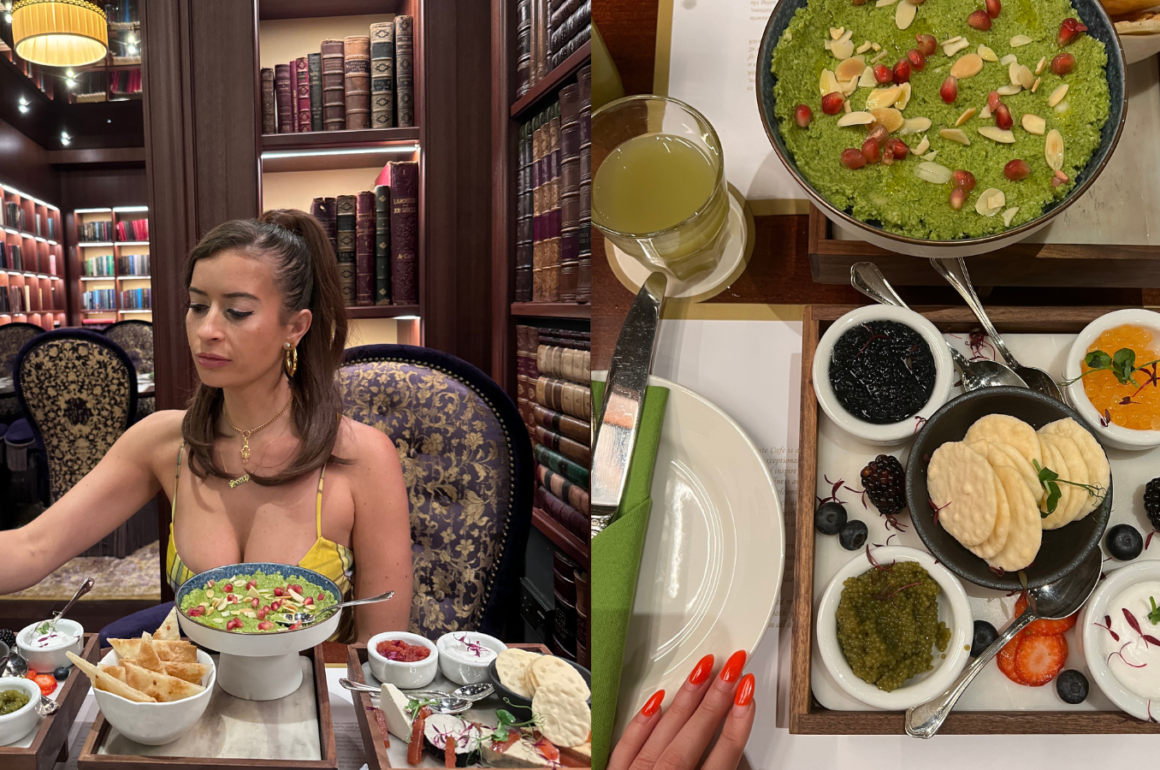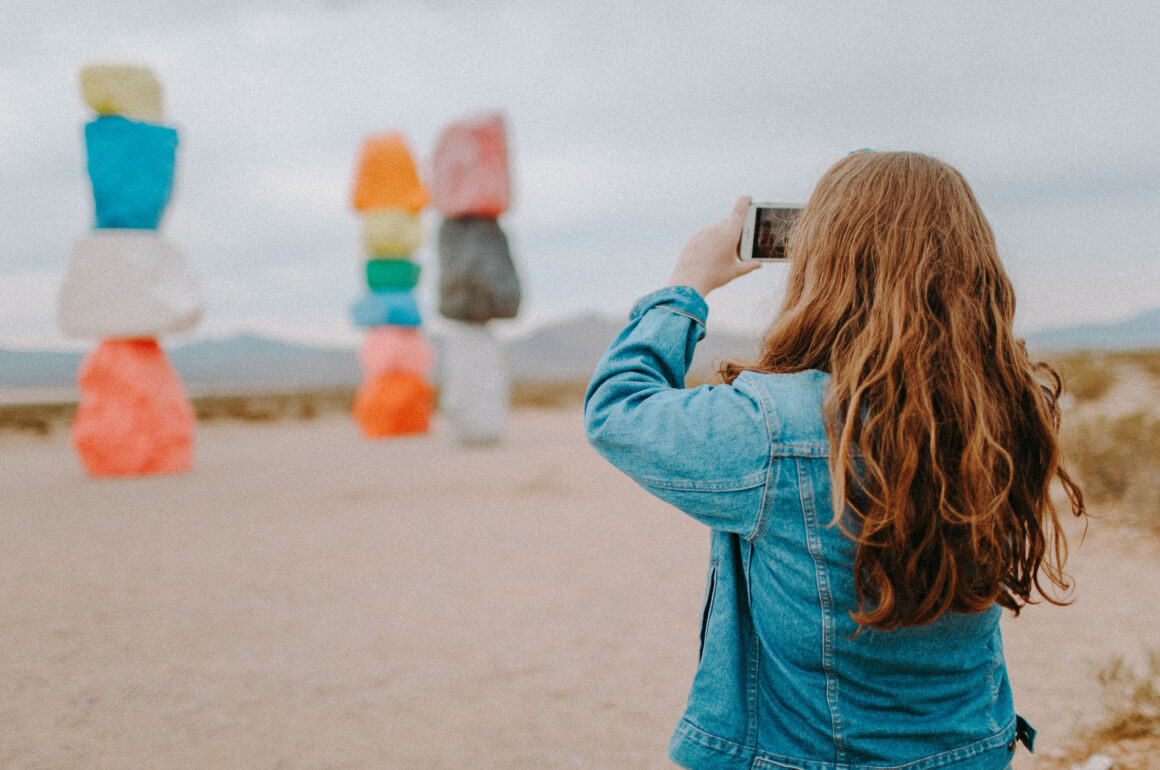Alright so, if you’ve been keeping up with my latest blog posts, you may know that I recently took a “traditional” 9-5 job. But, for the last two years I had been freelancing full-time and living the digital nomad life and lots of people asked me for more info on how to work while traveling or what I did for a living that allowed me to travel so much (hint: as much as I’d like to, I don’t pay the bills from taking bikini shots for IG).
So, here’s a sort of explainer/breakdown on what I was doing as work while traveling that paid the bills and allowed me to travel so often. Also info on how I got started, any tips and tricks, and the things (and people) who helped me out.
First, for a little background, before I went freelance I was working at a digital platform/magazine as a staff writer/assistant editor. I had done similar freelance writing work up to that point, but none of it paid that well. My full-time gig wasn’t paying that well either, so I decided to quit and try to make enough money freelancing to work while traveling (I also had around $15-20k saved up at this point because this had been a long time coming).
Want to Work While Traveling? Here’s How I Did It:

How Did I Get Started?
I got started writing by securing an internship with Galore. I assumed I’d be getting coffee, but they asked me if I could write and I was like, “sure, sounds fun.” Ultimately they were happy with the numbers my pieces were getting and asked me to stay on as a freelancer while I finished college.
About a month after moving back to DC and going freelance, I met a guy out at a bar who, like me, was also not drinking. We texted for a bit before it came up that I was a writer, and he told me he owned a digital consulting firm and had tons of projects that he needed a good writer on. We got dinner and I agreed to take on two projects for him: one for an OBGYN practice that was opening soon in the area and another for a mobile app called KNGRO. I had never priced something out as a project rate before, I think at this time I’d never even given my own rates (I’d just accepted whatever per piece rate a publication offered). I had also never done anything close to consulting, building a strategy plan, etc. But the guy, Roy, said he could tell I was smart and he was always around if I had questions. We had many late night Google Hangout conferences, and I had lots of questions, but we eventually turned both projects around and both clients agreed to sign on for long term contracts for us to manage their social channels, which I’d also be working on.
I talk more about how I first found the rest of my early clients later on, so keep reading!
If you’re looking to get into writing, I recommend starting a blog (although admittedly, I didn’t start a blog until I was writing professionally). That way you’ll have something to show editors when they ask to see examples of your work. Internships are also good, but most writing ones are unpaid and if you’re going to write for free, you might as well write about what you want and on your own platform.
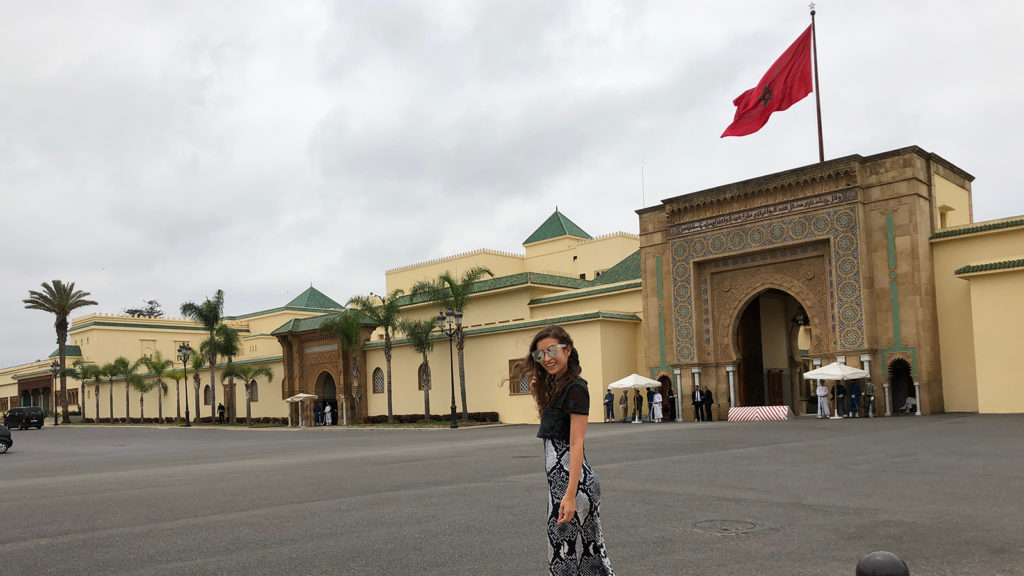
What Did I Do For Work & What Paid The Majority of My Bills?
I liked to think of my freelance income as a pie chart. While I’d love to tell you that 50% of my income came from social media work, 25% came from copywriting, and 25% came from writing for media outlets, it really differed each month.
Occasionally I had social media clients that wanted a lot of management, and would give me a monthly retainer of anywhere from $1000-3000 depending on their needs/what I asked for. Some clients simply wanted 12 feed posts a month, some wanted one post every day plus Instagram story posts and engagement (responding to messages, comments, etc.). This work involved writing, graphic design (I’d create and/or edit the images myself), plus strategy—and lots of lots of time on my phone. Oh and, if I was negotiating a contract myself, sometimes it also involved writing up a contract (along with the help of a lawyer friend I met through Twitter who would so graciously assist me).
Based on my data, my average monthly gross income in 2018 was $3,371/month, so sometimes one social client gave me over 50% of my monthly income. But sometimes I didn’t have any big social clients (when a startup is low on funding, social is usually one of the first things they cut), or sometimes I lost them unexpectedly, so I never got too comfortable.
The “fun” writing I did for Galore and went on to do for HelloGiggles, Bustle, Vice, etc., almost never made up the biggest piece of the pie. The journalism industry is not the place to go if you’re looking to make money, plus the time I would spend finding a new editor’s contact info, crafting up pitches, and sending follow-up emails was unpaid time that sometimes resulted in zero returns for me.
To give you an idea of how much I get paid to write for “fun” publications, most of them pay flat rates rather than per word, starting at around $75 a piece and going up to $300. Word rates for online publications are usually around .20/word, although I’ve gotten paid closer to .70/word for print. There are also definitely publications that will try to get away with paying you like, $25 for a piece (and I definitely wrote for some of them, like totalfratmove.com, briefly in college).
If you’re okay with getting low-balled and just trying to get your foot in the door, just keep track of how long it actually takes you to write a piece to make sure it’s worth your time. I write really fast, so sometimes I can convince myself I’m okay with something that doesn’t pay great because I can bang it out. And always try to negotiate for a little more! It doesn’t hurt to ask (although admittedly, I wasn’t asking until recently). I will try to write a more in depth blog post on this in the future if there’s interest!
In addition to writing and social media, I started doing a good bit of copywriting. No, it has nothing to do with law. Copywriting involves pretty much any writing done for a business. For example, if you go to your favorite e-commerce website, everything from their “about us” to their FAQ to their blogs to their product descriptions are done by a copywriter. I worked on copywriting for some of my social clients, plus one-offs for new businesses or brands that needed a revamp. My rates for this started at .20/word, but depended on the subject (certain subjects would require more research on my end).
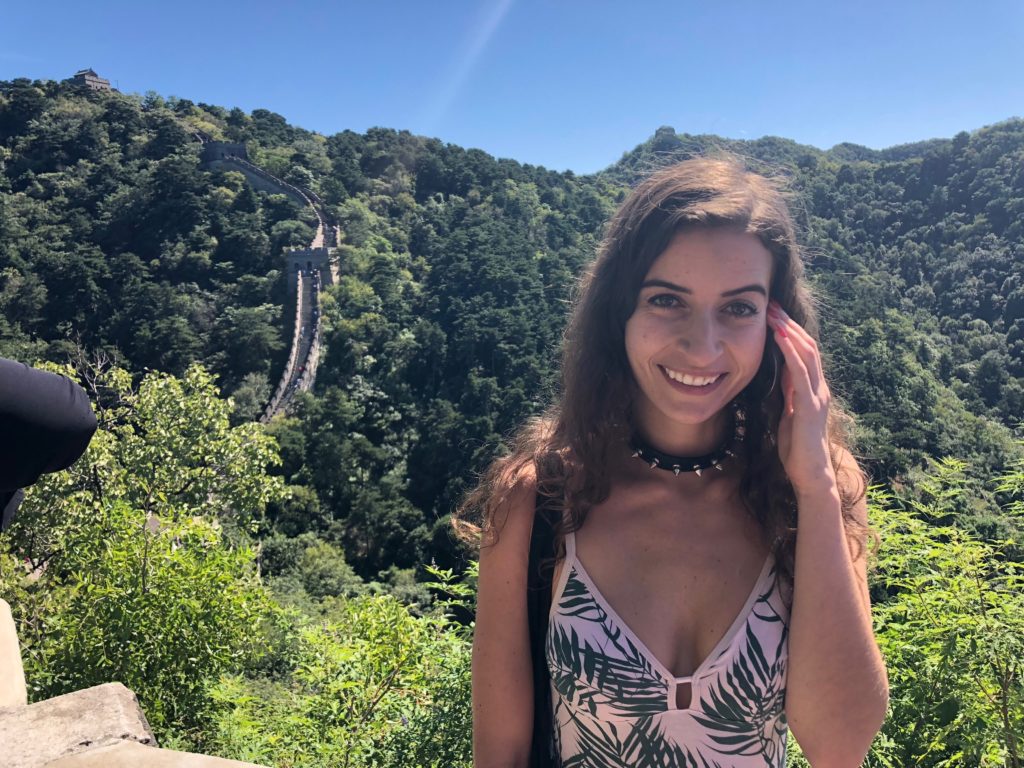
How Often Did I Work?
I know, I know, my social media feed makes it look like I’m on a permanent vacation, but I promise I spend more time working than sitting by the pool.
All my friends knew me as the girl who constantly had her laptop + backpack nearby. If I had so much as a free five minutes, I’d open my laptop and start getting work done. Instead of working 9-5, on an average “work” day I worked from 10am-9pm (plus about an hour break for lunch and yoga).
I say average “work” day because obviously I didn’t have to work Monday-Fridays like most people. Generally, I’d work every weekday from 9 or 10 am until anywhere from 7 PM to midnight. A lot of times I’d do work on Saturdays and Sundays too, depending on my workload and my schedule. I’m really not someone who’s good at relaxing, so unless I had plans with someone or was cooking, you can probably bet that I was working. Even when I was traveling, my daily plans were generally to take a nice walk to a cute cafe and work from there.
Because I’ve always been a bit of a workaholic and I liked what I was doing (not to mention that I got to do things on my own time), I didn’t mind working all the time, but sometimes I did envy my corporate friends who were able to actually take a week off. Sure, I could take a week-long (or hell, a month long) trip, but I’d still have to be checking in on things at least once a day unless I wanted to lose all my clients and therefore lose all my income.
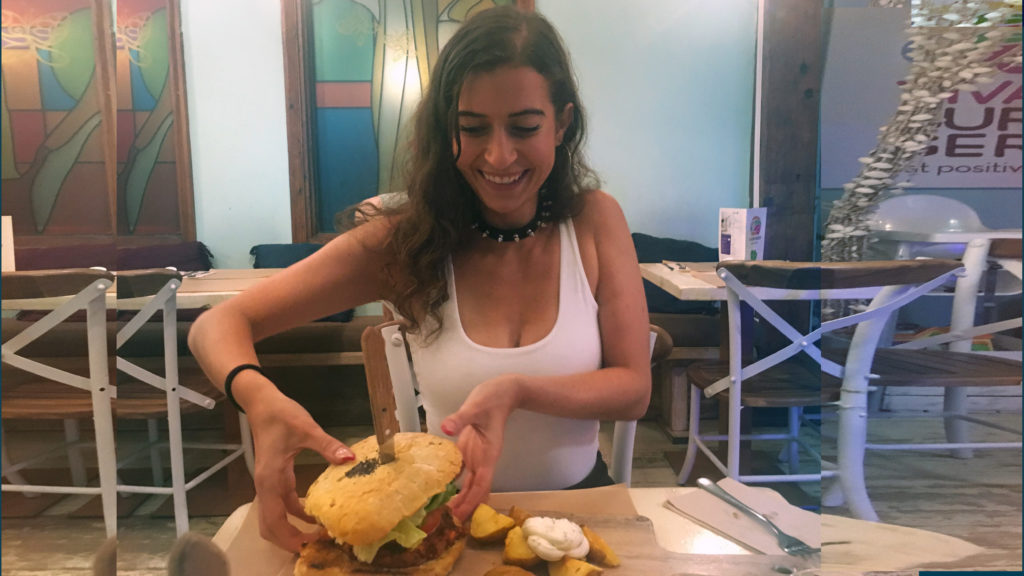
Where Did I Find Clients?
Finding clients was what I assumed would be the trickiest part of freelancing for me, because I’m awful at selling myself. But, thanks to some internet resources and previous work I’d done, I never found myself needing to look for work. In fact, just a few months into freelancing, I found myself actually learning to say no to work because I just didn’t have time to do it all.
When I first started, I found a few gigs through a Slack channel called World of Writers, which I found through a Facebook group for Digital Nomads that I had joined a while ago. Some of these gigs were low-paying one-offs, like the SEO-copywriting I did for a VR porn site, but some of these were decently paid ongoing gigs, like a ghostwriting gig where I ended up writing 1-4 beauty blogs a month for a skincare company (I still work with this client—plus other clients that they recommended me to).
From there, I met Roy from Digital Revamp (as I mention in my intro), and he was constantly bringing on new clients and asking for me to help out on projects. I met another friend through my MBA program that had a similar agency, and I occasionally did some copywriting for his clients as well (although since my rate was a lot higher than their usual writer, they only enlisted me for clients that needed special attention).
Other projects, believe it or not, came from the writing I did for Galore (or at least the people I worked with at Galore). People who had read my stuff and liked my voice (or were looking for a similar voice for their project), reached out asking me to work with them.
When it comes to pitching editors or doing more blogging-type work, my best method is generally just following editors and other writers on Twitter and keeping an eye out for when an editor does a call-out for pitches. There are also other helpful Facebook groups like Binders Full of Writing Jobs where you can find writing gigs, but just like job posting sites, you have to apply and compete with tons of other people who are looking for work (and considering the constant media layoffs, it’s competitive).

How Did I Plan Out My Finances?
In case you haven’t noticed, I am a planner, and I am not a risk taker when it comes down to it (especially not when it comes to finances). My senior year of college, I had my finance major boyfriend make me a lil’ budget Excel doc and I’ve been using it since. I track nearly every last dime I spend and have a budget for all the different “categories” that I spend on (dining, groceries, subscription services, transportation, etc.). I also track all the money that I make each month (as most freelancers do).
In 2018, my monthly budget was about $700-1000 each month. Although I often went over that number, I always ended up “in the black” each month aside from April—the month that I had to pay my medical bills for my surgery.
As I mentioned, I had at least $15k saved when I quit my job, so I definitely could’ve dipped into my savings if I ever had an off month, but I didn’t want to because I knew I’d want that money for something more important down the line (like, for example, the car I’m about to buy).
If it was nearing the end of the month and I noticed that I was in the “red,” I would scrounge up some extra freelance work, try to stop going out to eat, or whatever to make sure I at least broke even. But realistically, I actually ended up putting a lot of money away each month, even with traveling.
For your viewing pleasure, here’s what the month of June 2018 looked like for me:
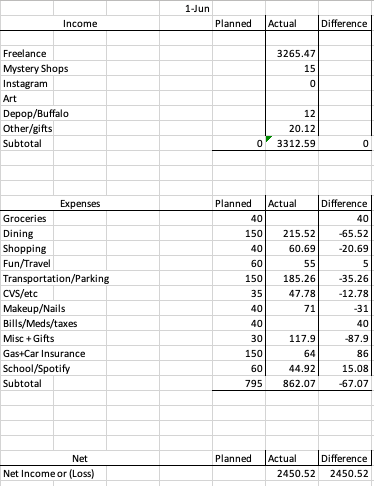
I got a little savvier this year and split my freelance income into categories, here’s February and March of 2019 to show you how much things vary. In February I lost my biggest social client and was traveling in Thailand for two weeks, and you can tell. You can also tell that I was moving in March, because I made nearly $400 from selling stuff, I paid two months of rent, and I spent lots of money on flights, baggage, etc. (I put it in the expense category because I’ll write it off on my taxes).
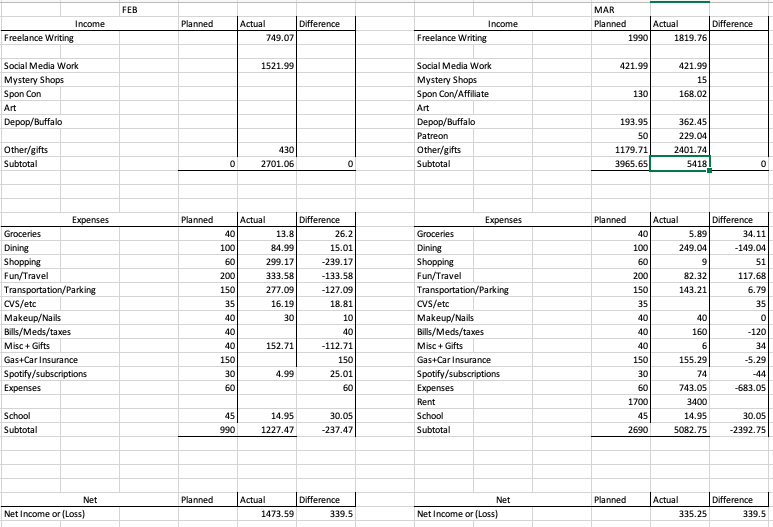
If this looks unrealistic to you, keep in mind that I’m literally a psychopath when it comes to spending money—I’m disgustingly cheap! Like, carrying around tea bags and asking Starbucks for free hot water cheap. Still using my student ID to get discounts cheap (maybe money-saving tips should be my next post?).
Also keep in mind that I had the privilege of living rent-free because my “home base” was my parents’ house in DC, and I rarely spent money on groceries due to my mom so graciously picking up my few necessities (kale, rice cakes, hummus) from the grocery store for me when I was home. If we’re going to get really honest about privileges here (which I want to, because that’s what so many bloggers and “success stories” seem to skip), I was also dating a guy last year who would pay for most of my transportation when I would visit him either in NYC or wherever he was traveling for work once a month—I also rarely spent money on food whenever I was staying with him.

Is Being a Digital Nomad As Fun As It Sounds?
Living the digital nomad life is definitely not as glamorous as it sounds, and I absolutely would not recommend it for anyone who’s not extremely self-motivated (not to mention anyone who doesn’t like spending a lot of time alone).
Now that I’m working a corporate-ish 9-5, my eyes are definitely opened to a lot of the perks of a 9-5 that I maybe didn’t see while working as a freelancer (I’ll be writing a full blog post on this later). Like most things, the grass is always greener on the other side.
Because of my tendencies, I’ll probably always be doing a bit of freelancing in some capacity. So I’ll still get some of the perks (fun projects, extra income) and the not-so-fun parts (chasing down paychecks, clients expecting you to be available at all times) to remind me.
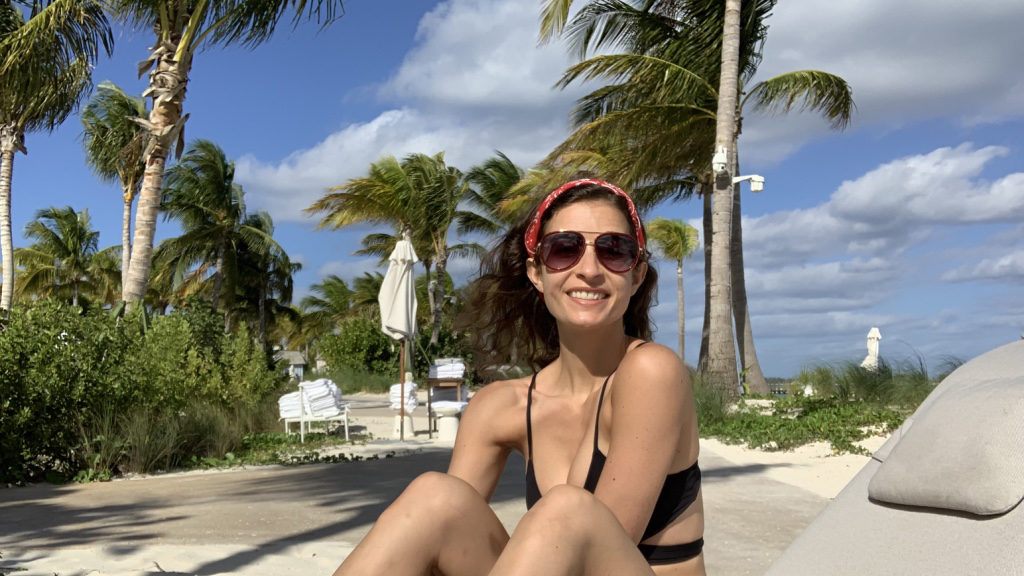
What about all the travel-hacks to travel for cheap?
Somebody asked about this on Instagram, and I’m not the right person to give you tips on how to travel for cheap. The only thing I sort of looked into in terms of “hacks” is Scott’s Cheap Flights, which sends you flight deals to your inbox regularly. They’re definitely good deals, but require planning many months in advance, and it’s too difficult for me to know where I’m gonna be (and what I’m gonna want to do) so far ahead, so I never used it.
Hostels are always a great way to spend less $ on lodging (which is always the priciest part of traveling), but I’m a little too private/boujee for that, so I would usually stay in an affordable Airbnb in which I’d pay around $35 a night to stay in a private bedroom in a shared apartment/house.
All the other ways I saved money traveling were just common sense: taking the local subway system instead of getting a taxi from the airport (my arms were bruised for weeks after lugging my suitcase up the subway steps in Madrid), packing snacks so I don’t spend unnecessary money on food, bringing a carry on instead of checking a big bag, etc. Oh, and not drinking helps.
I feel like everyone wants a “secret” to traveling affordably, but the secret — at least for me — is simply living more frugally in your regular life so that you can comfortably ball out (at least a little) while you travel. I also recommend a card that gives you good travel rewards! I know the company is a bit problematic, but the rewards I get on my Uber card are great.
I hope this blog post gave you a little more insight into what I actually do/did for a living. As much as I cringe at the overused title, what I was doing really could all be grouped into the role of a “content creator,” more than solely a writer. As always, happy to answer additional questions in the comments section.


